
Telecommunications serve as the backbone of modern connectivity. It is no longer just about phone calls and higher downloading speeds, rather, it’s like a launchpad for the unimaginable. The emergence of amazing trends in telecommunication, like the transformative power of Artificial Intelligence, the rapid deployment of 5G, and the immersive experiences offered by Metaverse, is a revolution unfolding before our eyes.
Even statistics reveal the significant growth and value of the telecom industry. “The Global Telecommunication Market was valued at USD 1754.8 Billion in 2022 and is projected to reach a value of USD 2652.5 Billion by 2030 at a CAGR (Compound Annual Growth Rate) of 5.3% between 2023 and 2030.”
Let’s look at some more of the latest numbers. By 2027, global telco data traffic will nearly triple, reaching 9.7 PB. The explosive growth in data consumption highlights the increasing demand for high-speed, low-latency connectivity. Additionally, 79.4 zettabytes of data will be generated by connected IoT devices in 2025, with video leading the surge. This reinforces the need for edge computing and AI-driven data processing to manage this volume efficiently.
Join me as I explore the top 9 telecommunications future trends i.e. the latest technologies in telecommunication, understanding their transformative role and exploring their potential, one trend at a time.
Let’s begin!
Top 9 Emerging Telecommunication Trends
1. 5G Steals the Limelight
We have already stepped into the 5G era, and it is here to stay (at least until the 6G arrives). It represents the fifth generation of mobile networking and the newest iteration of cellular network technology. 5G promises significantly blazing-fast data speeds (10x than 4G), lower latency, and massive capacity compared to previous generations. The 5G technology works on higher frequency bands and advanced antenna technologies. For the telecommunication companies, it’s certainly a boon.
From 1.76 billion in 2023 to 7.9 billion by 2028, global 5G connections are set for explosive growth. Source
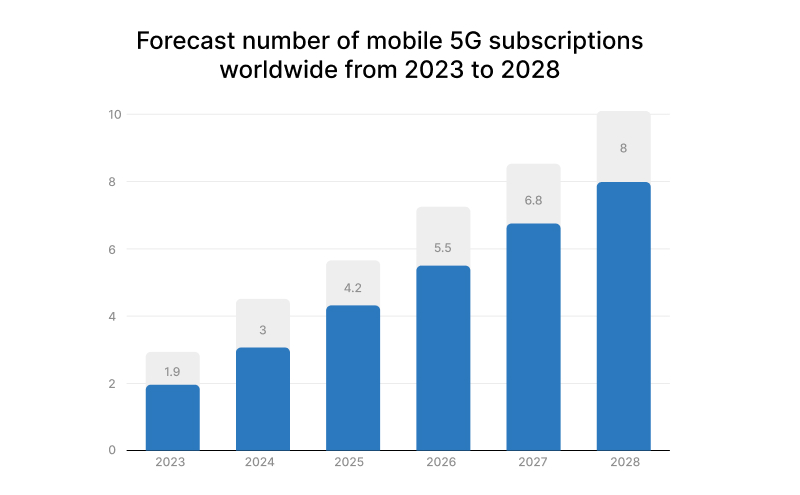
By leveraging 5G, telecom companies can provide seamless communication services as users can expect enhanced broadband experiences like downloading an entire movie within the blink of an eye and even experiencing lag-free virtual reality. Yes, that’s the promise of 5G.
In terms of speed, 5G networks are set to bring an array of benefits. With a speed as high as 20 Gbps, users can expect UHD, i.e., Ultra High Definition Videos at 8k resolution to stream smoothly over the internet!
But wait, it’s not just the speed where 5G shines. The time taken while sending and receiving data over the internet, i.e., Latency, is also near-instantaneous. Users can experience real-time responsiveness with latency as low as 1 millisecond. Imagine how beneficial it could be in critical applications like remote surgery and autonomous vehicles, where every millisecond counts.
Additionally, 5G excels with its massive capacity as well. Compared to 4G, it can connect 100 times more devices per unit area. So, in a crowded area like a stadium where everyone’s streaming, gaming, calling, and whatnot, 5G ensures smooth connectivity.
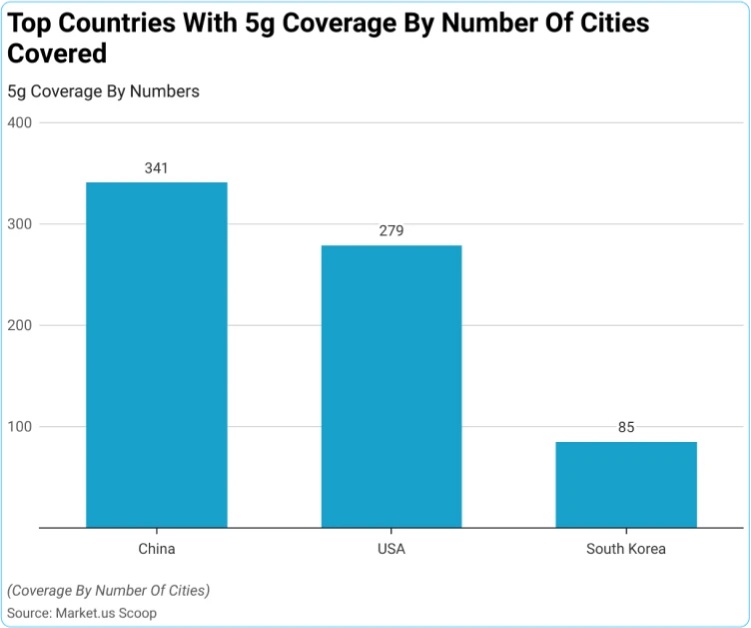
According to FinancesOnline, “The top three countries that have established 5G in their cities are China, USA, and South Korea.” The above image represents the top three countries with the number of cities having 5G deployment.
What’s Ahead in 5G?
5G has entered the mainstream, and going ahead, it will act as a catalyst for innovation and transformation across various industries, including telecom. In essence, we can expect to see the wider adoption of 5G standalone services, leading to a large range of applications with improved reliability and extremely low latency.
Next, we have 6G – the emerging frontier, set to use new spectrum bands like the terahertz band for ultra-fast data speeds and minimal latency.
2. Cloud Computing – Powering the Digital Age
Another frontier trend in telecommunications is Cloud Computing. It is steering telecommunications into a new era once anchored in physical infrastructure and on-premise solutions. According to MarketsandMarkets, “The Global Telecom Cloud Market is estimated to reach $32.5 billion by 2027, growing at a CAGR of 23.1%”.
Today, telecom companies can easily ditch bulky hardware setups and on-premise servers as the Cloud enables them to manage their entire network through a virtual dashboard. Scalability is one of the key benefits of cloud computing, enabling telecom operators to scale up and down based on the fluctuating demands of the consumers. Operators can quickly adapt to the changing market conditions and even experiment with new services or business models to stay competitive in the market.
As per Juniper Research, “Telecom IT spending on cloud is expected to reach 26% by 2024, up from 18% in 2022.”

Cost is an added advantage for telecom operators when they migrate to the cloud, as the expenditures shift from CapEx to OpEx. According to McKinsey & Company, “Cloud adoption enables 30% to 50% cost savings for telcos”. Further, it has been found that for 85% of telecoms, cloud computing is crucial for their digital transformation.
What’s Ahead in Cloud Computing?
The above statistics paint a clear picture – the cloud revolution will simply go beyond technology; it will be like a cultural transformation. We can expect hybrid and multi-cloud adoption and tailored cloud solutions specific to the needs of telecoms.
3. Internet of Things (IoT) – A Connected Future
There was a time when IoT was a huge buzz; however, today, it has become an amazing reality. It has transformed the way we live, work, and interact with the world around us. We are surrounded by everything ‘smart’ – from smart homes and wearables to connected cars and even industrial sensors.
Statista reveals that by 2030, the number of interconnected devices data is projected to reach 30 billion.
This surge in IoT devices has sparked the demand for robust and scalable connectivity solutions. The sheer amount of data generated by IoT devices is leading to exponential growth in network traffic, sometimes creating unpredictable bursts that can overwhelm conventional networks. Moreover, it is not only about the amount of data traffic but also the diversity of the data that networks need to support.
Telecom Operators are investing in network infrastructure by deploying LPWANs i.e. Low-Power Wide-Area Networks to cater to the diverse requirements of IoT applications.
The global IoT market size is expected to grow from USD 300.3 billion in 2021 to USD 650.5 billion by 2026, at a Compound Annual Growth Rate (CAGR) of 16.7% from 2021 to 2026. Source
What’s Ahead in IoT?
We can expect a rising trend among telecom operators forging partnerships with IoT manufacturers and industry stakeholders to develop integrated solutions that align with the unique requirements of IoT applications. Having expertise in network infrastructure, data management, and security, IoT presents a transformative opportunity for telcos to drive innovation, connectivity, and new revenue streams.
4. AI and Automation – Driving Innovation

AI artificial Intelligence, and Automation are two powerful emerging technologies that have revolutionized almost every sector, and telecom is no exception. In the realm of network operation, AI algorithms help optimize the network by predicting and preventing network outages, optimizing traffic flow, identifying congestion, and ensuring the efficient allocation of resources. This leads to reduced downtime, improved network performance, and lower operational costs. Furthermore, self-healing networks, i.e., autonomous systems powered by AI, are capable of detecting and resolving network issues without any human intervention.
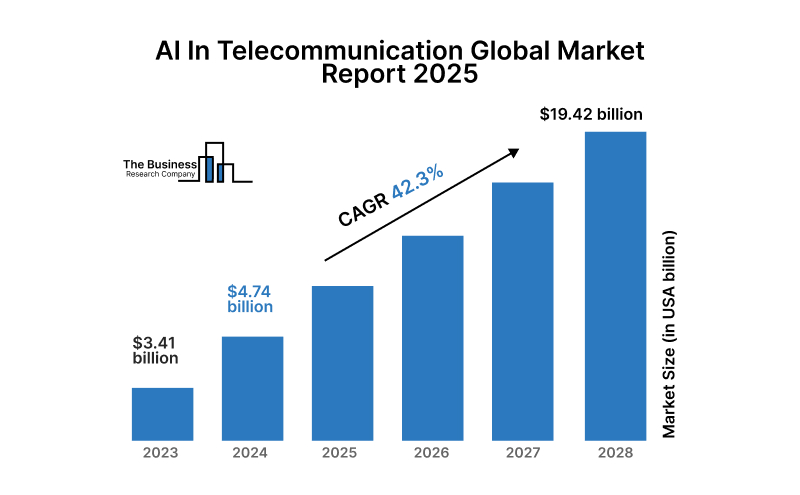
Another area where AI and automation are helping telecom companies is Customer Service. In the telecommunications sector, 52% of companies now use AI chatbots, simplifying customer interactions and improving efficiency. Leveraging AI-powered chatbots and virtual assistants, telecoms can improve their customer service by offering 24/7 support, answering FAQs, and resolving repetitive issues. This helps boost customer satisfaction, reduces operational costs, and delivers personalized experiences. AI-powered chatbots have succeeded in lead generation, with 26% of B2B marketers reporting a 10-20% increase in lead volumes. Source
Besides this, AI and automation are also critical for network security and operations management. Major telecom operators, including Telefonica, Vodafone, and Verizon rely on AI and automation to optimize network performance and enhance customer service and innovative product development.
What’s Ahead in AI & Automation?
AI-driven engagement solutions offer significant revenue-generating opportunities for telcos. As AI continues to mature, telcos are likely to increasingly rely on AI-powered solutions to thrive in this digital ecosystem.
5. Metaverse – The Future of Digital Interaction

Avatars need no introduction. Such immersive experiences, which were earlier only a part of science fiction, have now intertwined with our physical reality. And at the heart of the metaverse lies telecommunications, which play a central role in shaping its infrastructure and accessibility.
The Metaverse market is projected to reach a value of US$74.4bn in 2024. This market is expected to grow at an annual growth rate (CAGR 2024-2030) of 37.73%, resulting in a projected market volume of US$507.8bn by 2030. Source – Statista
Telecom companies are leveraging their infrastructure to facilitate seamless connectivity and low-latency interactions within simulated environments. This trend promises immersive experiences beyond video games, encompassing virtual meetings, social gatherings, and more.
Let’s have a sneak peek at how telecom is shaping the metaverse trend with some exciting examples and compelling figures:

- Verizon is investing heavily in 5G infrastructure, positioning itself as a key player in metaverse connectivity.
- Deutsche Telekom is collaborating with Nokia to develop edge computing solutions for metaverse applications.
- Orange is using network slicing to offer dedicated bandwidth for VR gaming experiences.
What’s Ahead in Metaverse?
Telecoms are expected to enhance their current connectivity, i.e. 5G and future iterations like 6G, to ensure smooth metaverse experiences.
6. Cyber Security – Guardians of The Virtual World
A 2023 global EY study revealed that 53% of telecom companies anticipated cybersecurity breaches costing over $3 million. Additionally, 74% believed their organizations needed to step up efforts to combat AI-driven threats.
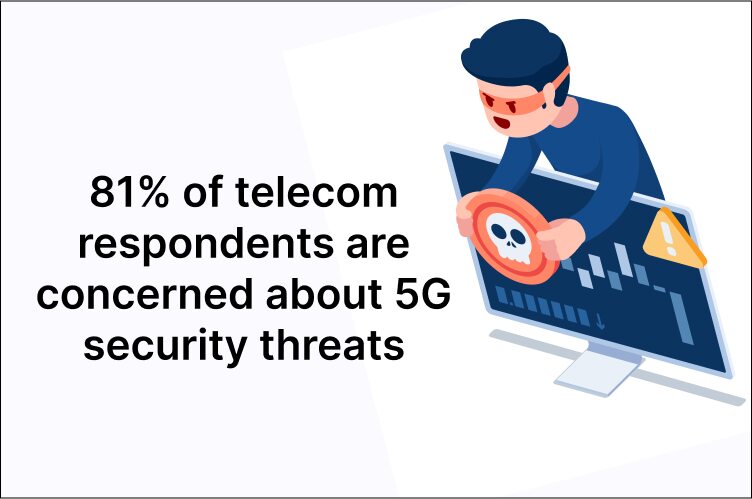
With the advent of 5G, the proliferation of IoT, and the escalating frequency of sophisticated cyber-attacking techniques, cyber security remains a paramount concern for the telecom industry. With cyber threats and attacks on the rise, hackers and hacktivists (88%), corporate espionage (80%), and low employee awareness (73%) are considered the top concerns in the telecom landscape (source).
The global cloud security market size is projected to reach USD 75.26 billion by 2030, and is anticipated to register a CAGR of 13.1% from 2023 to 2030, according to a new study by Grand View Research Inc.
Telecom operators are increasingly investing in robust cyber security measures like implementing encryption and conducting regular security audits to protect the integrity and security of their networks. Additionally, the emergence of AI and ML has enabled proactive anomaly detection and threat mitigation, further helping to fortify the networks.
What’s Ahead in Cyber Security?
The future of cybersecurity in the telecom domain is characterized by continuous adaptation and embracing cutting-edge technologies. We can expect an increased integration of AI and Machine learning for comprehensive threat detection and prevention.
7. Edge Computing – The Next Computing Frontier
Edge computing has become a big market and continues to grow at a great speed – the forecast global revenue is set to reach 274 billion U.S. dollars by 2025.
Edge computing has emerged as an effective alternative to centralized cloud computing, keeping pace with the demands of real-time applications, low latency requirements, and ever-growing data volumes. The concept behind ‘edge’ computing is that processing, storing, and analysis of data is done closer to where it is generated, i.e., at the edge of the network, rather than sending it to a central system.
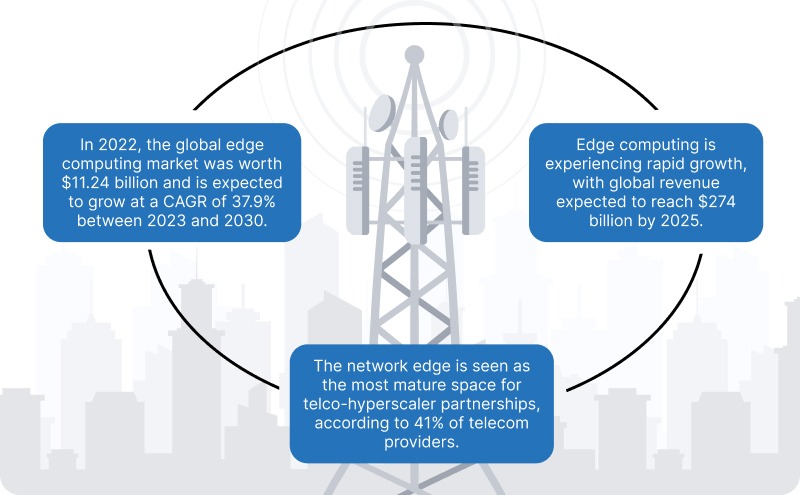
By bringing data computation and storage closer to the source, ultra-low latency is achieved, bandwidth gets optimized, and security and privacy are enhanced. As per a Juniper Report, “The total annual spend for telcos on Multi-access edge computing (MEC) will go from $5.4 billion in 2022 to $11.6 billion in 2027 with a CAGR of 16.7%”. Well-established companies like the retail giant Walmart, manufacturing leaders like Siemens, and transportation companies like Uber utilize edge-powered solutions to enhance their services. Further, Gartner predicts that “75% of all data generated will be processed at the edge by 2025.”
What’s Ahead in Edge Computing?
Edge computing is a fundamental shift in how we utilize data. By embracing this trend, telecom operators can unlock new opportunities, including the enablement of new services and generating revenue streams.
8. Software-Defined Networking – Transforming Network Infrastructure
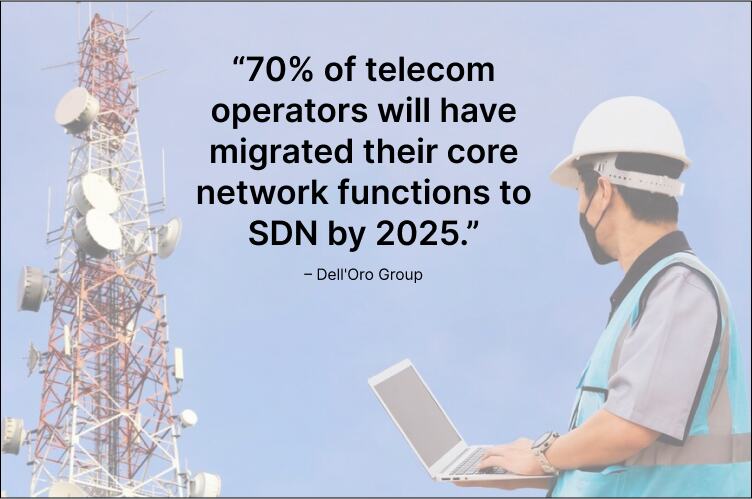
The global Software-Defined Networking market size is expected to grow from USD 24.5 billion in 2023 to USD 60.2 billion by 2028 at a Compound Annual Growth Rate (CAGR) of 19.7% during the forecast period. (MarketsandMarkets).
There are a lot of reasons why SDNs are gaining traction in the telecom industry – the rigidness of the traditional networks, the rising complexities of the networks, the need for rapid services, etc. According to Accenture, SDN enables 4 times faster rollout of new services compared to traditional networks.
Telecom operators around the globe are investing in SDN technology to modernize their networks, enhance service delivery, and meet the ever-growing demands of consumers for high-speed connectivity and new services. Let’s take a look at some prominent examples of SDN implementation in telecom:
- AT&T
AT&T deployed SDN by leveraging technologies like OpenFlow and ONAP (Open Network Automation Platform). Through this, the company aims to virtualize and automate various network functions, ultimately converting its entire network into a software-defined platform.
- China Mobile
The telecom giant leveraged SDN for network slicing to create dedicated virtual networks for individual services. This not only helped the company enhance the efficiency and flexibility of its network infrastructure but also optimized network resource allocation and automated service provisioning.
- Verizon
The American wireless network operator deployed SDN to achieve multiple goals, including enhancing the agility and scalability of its network infrastructure, optimizing traffic routing, dynamically allocating resources, and supporting new services.
What’s Ahead in SDN?
With the ongoing advancements in cloud and integration of SDN with other technologies, including AI and ML, it is easily predictable that SDN will empower telecom companies to deliver seamless, innovative, and efficient services to their customers. We can expect to see SDN playing a significant role in hybrid cloud environments and network security as well.
9. Sustainability – Greening the Telecom Landscape
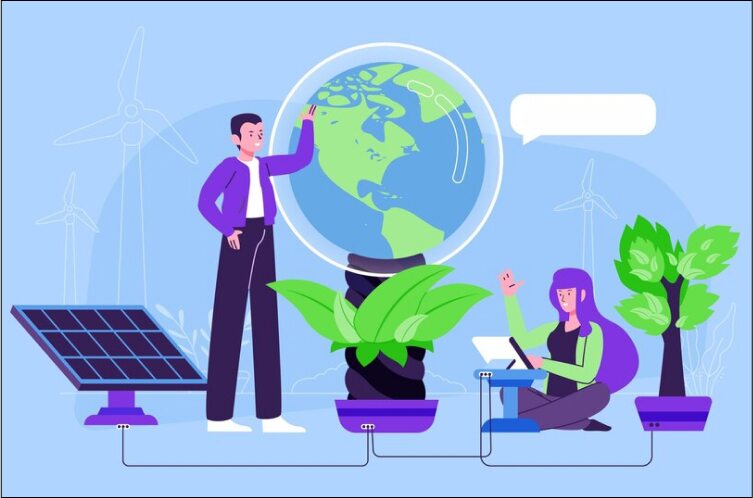
The ITU estimates that 53.6 million tonnes of e-waste were generated from electronic and electrical equipment in 2019, with telecom equipment forming a significant portion.
Being one of the biggest contributors to global energy consumption and carbon emissions, the telecom industry is rapidly turning toward sustainable initiatives. Many telecom companies are deploying energy-efficient cooling systems, optimizing server utilization, and using renewable energy sources. The replacement of copper cables with fiber optic cables is also gaining traction as it significantly reduces energy consumption.
Telecom companies are also working to reduce plastic and electronic waste by using resources more efficiently and making sustainability a key part of their business. This includes creating longer-lasting products, recycling old devices, and supporting eco-friendly supply chains.
The telecom industry’s sustainability score has increased by 9 points, thanks in part to improved transparency in reporting, as noted in the Telco Sustainability Index.
Besides this, telecom companies are making significant investments in solar and wind farms to use renewable sources of energy for their operations. And that’s not all, there has been implementation of e-waste management programs for recycling purposes. Some key statistics that showcase the traction of sustainability in the telecom sector are:
- The GSMA or the Global System for Mobile Communications estimates that the telecom industry could eliminate 1.8 Gigatonnes of CO2e emissions by 2030 through energy efficiency measures.
- Deutsche Telekom, a German telecom giant, reduced its CO2 emissions by 14% between 2017 and 2020 through network optimization.
- Vodafone, the well-known multinational telecom, has committed to sourcing 100% renewable electricity for its global operations by 2025.
- Orange, a renowned French multinational telecom corporation, has set a target to collect and recycle 100% of its unsold and used mobile phones by 2025.
- The GlobalData report “Telecom & Green Energy – Thematic Research” predicts that the global market for renewable energy in telecom will reach $18.8 billion by 2027.
What’s Ahead in Sustainability?
Sustainable initiatives in the telecom industry will yield positive impacts such as reduced carbon footprint, lower operating costs, and improved brand image. Looking ahead, sustainability is expected to remain a top priority for the telecom industry.
Impact of the Top 9 Trends in Telecommunication
The convergence of all the above-mentioned trends in telecommunication is bringing transformative impacts. Embracing the power of AI, telecom operators can optimize their networks and enhance customer service. With SDN’s agility, Edge, and Cloud Computing’s real-time processing, low-latency applications, and scalable services, telecoms can tap the untapped potential in the telecom sector. Through sustainability initiatives, telecom companies can use less energy, reduce their carbon footprint, and help the planet. Together, all these innovations will help make communication faster, smarter, and greener.
Future of Telecommunication – What’s Ahead?
Having stepped into 2025, we can anticipate a wave of ongoing innovations in telecommunications and emerging digital trends, driven by ever-evolving customer demands. The rollout of 5G, the adoption of edge computing, and the expansion of IoT bring along several challenges for telecom operators, but they also create a pool full of opportunities to thrive in today’s increasingly interconnected world.
In 2025, the telecom marketing trends will be smarter, more connected, and AI-driven. Telcos must adapt quickly to lead the next era of telecom innovation.
Frequently Asked Questions
What is the latest technology in telecommunications?
The latest technological advancements in telecommunications include 5G expansion, AI-driven automation, edge computing, private 5G networks, and quantum communications. Some of the major benefits offered by these technologies are enhanced connectivity, speed, and security across industries.
How are technology trends in telecommunications shaping connectivity?
The latest technologies, such as 5G, fiber optics, IoT connectivity, and AI-driven network intelligence, are improving speed, reliability, and overall user experience in telecommunications.
What are the emerging telecom technologies businesses should watch?
Businesses should keep an eye on private 5G networks, edge computing, blockchain in telecom, and AI-powered network management for enhanced operations and security.
Is 5G evolving, how, and what comes next?
5G is expanding with network slicing, ultra-reliable low-latency communication (URLLC), and massive IoT connectivity. Meanwhile, 6G research is underway, promising terahertz communication, AI-driven networks, and enhanced spatial computing.
What innovations in telecommunications are improving cybersecurity?
There has been a growing adoption of AI-powered threat detection, quantum encryption, multi-factor authentication (MFA), and zero-trust security models by telecom service providers to combat evolving cyber threats.
How are telco trends influencing digital transformation?
Telecom companies are accelerating cloud migration, AI-driven automation, and software-defined networking (SDN) to enable more agile, cost-effective, and customer-centric operations.
What are the biggest challenges in adopting new telecommunications technology?
Some of the major hurdles in adopting the latest telecom technologies include high infrastructure costs, cybersecurity threats, regulatory complexities, spectrum allocation, and the need for a skilled workforce to implement and manage next-gen networks.
Note: This post has been updated with the latest information on 07-04-2025.




























